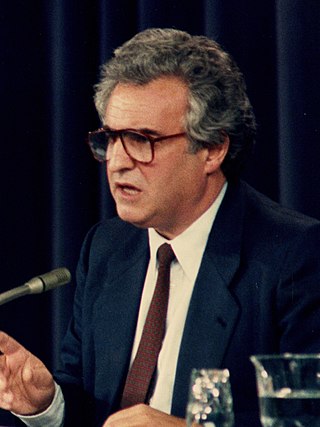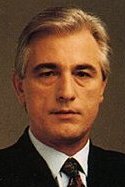
Isidora Dolores Ibárruri Gómez, also known as Pasionaria, "the passionate one" or Passion flower", was a Spanish Republican politician of the Spanish Civil War of 1936–1939 and a communist known for her slogan ¡No Pasarán! issued during the Battle for Madrid in November 1936.

Mariano Rajoy Brey is a Spanish politician who served as Prime Minister of Spain from 2011 to 2018, when a vote of no confidence ousted his government. On 5 June 2018, he announced his resignation as People's Party leader.

Alberto Ruiz-Gallardón Jiménez is a Spanish politician and former Minister of Justice. He was mayor of Madrid between 2003 and 2011. A stalwart of the conservative People's Party (PP), he has previously been a leading figure in various local and national legislative bodies. In December 2011 Ruiz-Gallardón was appointed Minister of Justice in Mariano Rajoy's inaugural cabinet. He resigned in September 2014.

Fernando Fernández-Savater Martín is a Spanish philosopher, essayist and author.

The 1977 Atocha massacre was an attack by right-wing extremists in the center of Madrid on 24 January 1977, which saw the assassination of five labor activists from the Communist Party of Spain (PCE) and the workers' federation Comisiones Obreras (CC.OO). The act occurred within the wider context of far-right reaction to Spain's transition to constitutional democracy following the death of dictator Francisco Franco. Intended to provoke a violent left-wing response that would provide legitimacy for a subsequent right-wing counter coup d'état, the massacre had an immediate opposite effect, generating mass popular revulsion of the far-right and accelerating the legalization of the long-banned Communist Party.
The Premio Planeta de Novela is a Spanish literary prize, awarded since 1952 by the Spanish publisher Grupo Planeta to an original unpublished novel written in Spanish. It is one of about 16 literary prizes given by Planeta.
José María Ruiz-Mateos Sociedad Anónima (Rumasa) was a holding company founded by Spanish entrepreneur José María Ruiz Mateos and expropriated by the Spanish government on February 23, 1983.

Dionisio Ridruejo Jiménez was a Spanish poet and political figure associated with the Generation of '36 movement and a member of the Falange political party. He was co-author of the words to the Falangist anthem Cara al Sol. In later years he fell from favour with the Francoist State and eventually became associated with opposition groups.

Josep Anglada Rius is a Spanish far-right politician from Catalonia. He began his political career in the Spanish nationalist, ultra-Catholic, Francoist-leaning party Fuerza Nueva, effectively assuming the role of Blas Piñar's foremost representative in Catalonia, and is the founder and long-standing president of the party Platform for Catalonia. He was leader of the party till 2014 when he was expelled for "management deficiency".

Enrique Múgica Herzog was a Spanish lawyer and politician.
Irreligion in Spain is a phenomenon that has existed since at least the 17th century. Secularism became relatively popular among rich people in the late 19th and early 20th centuries, often associated with anti-clericalism and progressive, republican, anarchist or socialist movements.
Basque National Liberation Movement prisoners are all those people who have been imprisoned, placed on remand, or otherwise kept in custody due to their illegal activity in support of the Basque National Liberation Movement.

Luis Roldán Ibáñez was a Spanish Socialist Workers' Party politician known for being the director general of the Civil Guard when a big scandal of corruption arose in 1993. This case, along with the GAL case, greatly contributed to the defeat of the PSOE in the 1996 general election. Upon initiation of prosecution for his criminal activities, Roldán escaped from Spain in 1994. He surrendered in 1995 at the airport in Bangkok. Between 1996 and 1998 he was tried in a court in Madrid. He was sentenced to 28 years in prison for embezzlement, bribery, tax evasion, and fraud, which the Supreme Court increased to 31 years. He was from February 1995 in the prison of Brieva (Ávila), which is normally used to house women offenders but has a secluded unit in which men can serve their sentences. In 2005 he was allowed out of prison to work in an intermediate regime between the second and third degree.

Pedro Fernández Checa, usually known as Pedro Checa was a Spanish Communist who played a leading role in the party during the Spanish Civil War (1936–39). After the defeat of the Republic he was forced into exile in the Soviet Union and then Mexico, where he died.

Gabriel Urralburu Tainta is a Spanish politician who was President of Navarre between 1984 and 1991.

Fernando Sánchez Dragó was a Spanish writer and television host.

The Fernando Lara Novel Award is given annually in Spain by the José Manuel Lara Foundation and the Planeta publishing house to an unpublished novel in the Spanish language. The publication of the finalist (runner-up) work is not expected, although it is sometimes published by Planeta itself.
José Luis López de Lacalle Arnal was a Spanish journalist and trade unionist. A columnist for El Mundo newspaper, he was killed by ETA.

My Prison Yard is a 2008 Spanish prison drama film directed by Belén Macías. The female-dominated cast stars Candela Peña and Verónica Echegui alongside Ana Wagener, Blanca Portillo, Patricia Reyes Spíndola and Violeta Pérez.
Events in the year 2023 in Spain.
















